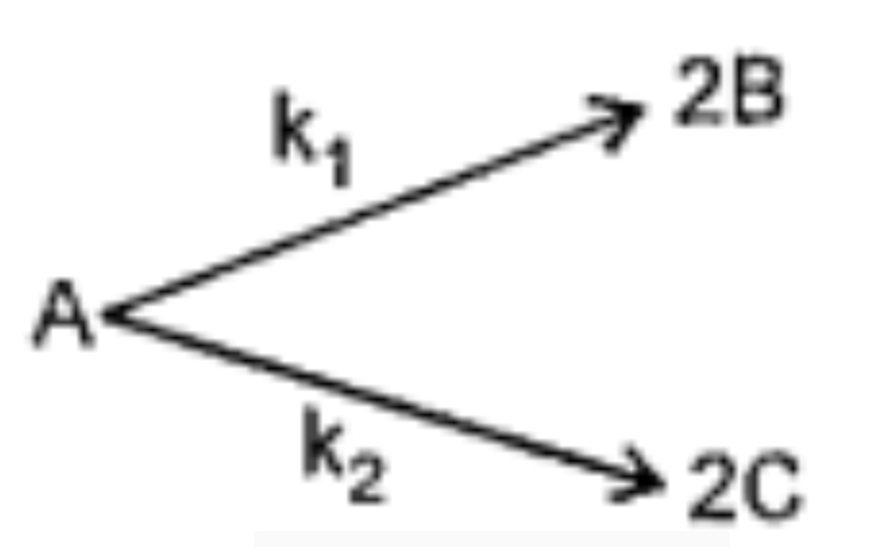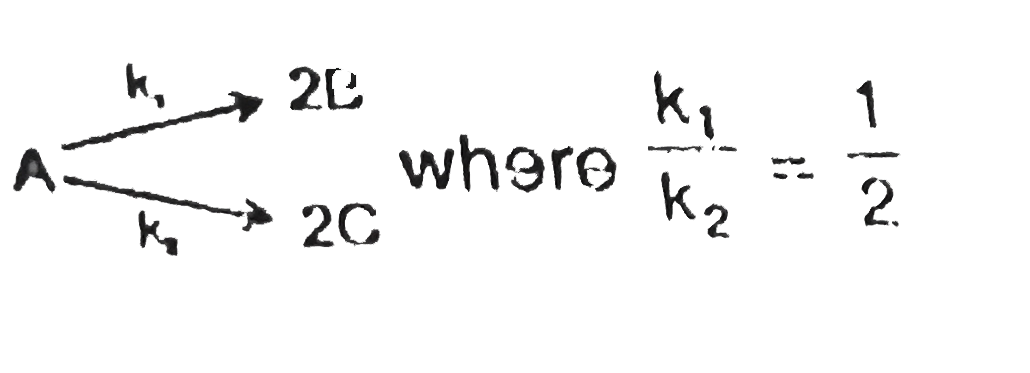For the elementary reaction where k1k2=12

Initially only 4 moles of A are present, What is the total number of moles of A, B andC at the end of 40% reaction?Solution in Bengali
∴ Moles of A reacted = 3
∴ Moles B producted = 1xx2 = moles and moles of C produced = 2×2=4 moles
∴ Total moles A,B and C = 1+2+4 = 7 moles.
Topper's Solved these Questions
Similar Questions
Which has higher conductance and why? Silver wire at 30∘C or silver wire at 50∘C?
03:32View SolutionIn a reversible reaction Aunderset(K_2)overset(K_1)hArrB the initial concentration of A and B are a and b in moles per litre and the equilibrium concentrations are (a-x) and (b+x) respectively, Express x in terms of K_1, K_2, a and b .
View SolutionFor given hypothetical elementary parallel reaction, Intially only 2 moles of A are present. The total no. of moles of A, B and C at the end of 75% reaction are:
View SolutionFor a hypotherical elementary reaction
 where k1k2=12
where k1k2=12
Initailly only 2 moles of A are present.
The total number of moles A,B and C at the end of 50% reaction are :View SolutionFor a hypotherical elementary reaction
 where k1k2=12
where k1k2=12
Initailly only 2 moles of A are present.
Number of moles of B are:View SolutionFor a hypotherical elementary reaction where k_1/k_2=1/2 Initailly only 2 moles of A are present. The sum of mole of (B) are ( C) is :
View SolutionFor reaction : A+2Bunderset("yield")overset(40%)rarr4C If 10 moles of A and B each are taken calculate number of moles of 'C' formed are:
02:27View SolutionWhen one mole each of CO and O2 are made to react at STP, the total number of moles at the end of the reactions is
06:45View SolutionThe curves x2a2+k1+y2b2+k1=1 and x2a2+k2+y2b2+k2=1 where k1≠k2 intersect at an angle
02:05View SolutionIn the sequence of reaction A to^(k_1) B to^(k_2) C to^(k_3) D , it is know that k_3 gt k_2 gt k_1 . Then the rate determining step of the reaction is:
02:02View SolutionA reaction is represented by A→k1B (slow).
A+B→k2C (fast). Where k1andk2 are the rate constants of the mechanistic steps. The rate of production of C will be given byView SolutionFor the reaction A overset(K_(1))underset(K_(2))(hArr)B , if 'a' is the initial concentration of A and n is the number of moles of A reacting if initially no B was present then :
03:07View SolutionIn order of reaction A overset(K_1)to B overset(K_2)to C overset(K_3)toD, K_3 gt K_2 gt K_1 So the rate determinant of the reaction is: -
05:03View SolutionFor a hypotherical elementary reaction where k_1/k_2=1/2 Initailly only 2 moles of A are present. The total number of moles A,B and C at the end of 50% reaction are :
03:32View SolutionFor a hypotherical elementary reaction
 where k1k2=12
where k1k2=12
Initailly only 2 moles of A are present.
Number of moles of B are , if reactions gets 50 % completed :03:36View Solution

